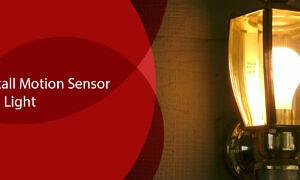
Floodlights from motion sensors are fine to get rid of backyard intruders, but they don’t look good at home. A motion detector with remote control is a better choice. It can be connected to any type of decorative fitting, including existing ones, and carefully mounted on the side. This article describes how to install a remote control sensor and connect it to a new or existing light.
Wiring is a bit more complicated than most electrical projects, but even beginners can handle it by following the wiring diagram provided. Apply for an electrical permit from your local laboratory so that an inspector can review your work. The hardest part of this project is laying the wires that connect the sensor to the light.
In some situations, you can find the wire through the finished wall. However, in many cases this project can only be done if there is an open tunnel, such as an unfinished garage or a large remodeling project. If rewiring is not an option, consider a sensor that gives similar results but has little or no rewiring.
Select a sensor for your home
Home improvement stores and hardware stores have motion sensors, as seen in floodlights. These are commonly referred to as replacement floodlight sensors, but they can also be mounted on mounting plates and used as remote sensors.
Before purchasing the replacement sensor, add the wattage of the lights controlled by the sensor. The wattage of the sensor should be at least the same as the total wattage of the device. For example, if you have two lights, each designed for a 100-watt bulb, the sensor rating should be at least 200 watts.
Place the junction boxes
The sensor and each lamp require an electrical socket embedded in the wall. You can also rewire the existing lightbox. Choosing the location of the motion sensor is not complicated. Check the manufacturer’s information about the range of view and arrange it so that visitors and intruders can see them when they approach the house.
Sensors typically detect movement best when placed 6 to 3 meters above the ground. The sensor used can be mounted in a circular or rectangular box. If the inner wall is incomplete, buy a box attached to the adjustable bar. This design allows the box to be placed anywhere between the studs.
Options for wiring
Before wiring the electrical cables to the junction box, you need to decide how to wire the system. Here is the easiest way. Pull power from the control box, connect the cable to the sensor, and then connect it to the light. You can also wire the cable to the bracket and then to the sensor. However, cable and connection details may vary slightly.
Just choose a method that facilitates the laying of cables. If you have only one light, simply disconnect the wiring that connects to the second device. The system requires a switch that can be used to cut off power to the sensor and lights. You can use an existing switch with an existing junction box. You may need to add more boxes to switch.
Connect the cable to the junction box
After deciding how to wire the system, route the electrical cables between the junction boxes. First, take a look at the existing wires used to power the sensors and lights. The plastic sheath of the cable has some numbers on it. The first number indicates the wire size. The second is the number of wires in the cable. Be sure to purchase a cable with the same gauge as the existing cable. You will need a 2-wire and 3-wire cable.
Take a step back and take a few minutes to plan the wiring of the cables. The shortest route is not always the best. Avoid paths that pierce narrow spaces or heavy frame members. In an unfinished garage, wire the wires high along walls or rafters that are unlikely to be damaged. If you only need to make a few holes, 5/8 inch is better.
The screws on the top of the bit allow you to speed up the drill with much less effort. After creating the cable path, route the cable from box to box and secure the cable to the frame with plastic clips. Place the staples within 8 inches and 4 feet 6 inches from each box.
Connect the lights and sensor
After arranging all the cables, you can connect the sensor and the light. You will want to rush this part of your project to see the results of your work but take your time. If the connection is incorrect, the system will not work. And it is a hassle to understand what went wrong.
When connecting to an existing cable, cut off the old bare end and strip off the insulation to show the new cable for the new connection. After all connections are complete, turn on the device and put the sensor in test mode to verify that the system is functioning properly. Next, aim the sensor and make adjustments.
Final thoughts
Motion sensor can be a good addition for your home especially if you are concerned about security. All homeowners want their family and home to be safe from intruders. Motion sensors allow you to keep your home safe without any hassle. It also gives you real-time updates depending on which kind of device you connect it with. You can connect the motion sensor with the entrance lights. This way when any visitors enter your home the hallway will light up. This will also save energy as the lights will only be switched on when they are needed and not all the time.






